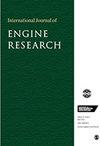Design of a novel impulse turbine for exhaust energy recovery in a commercial load carrier single cylinder diesel engine
IF 2.1
4区 工程技术
Q2 ENGINEERING, MECHANICAL
引用次数: 0
Abstract
A significant fraction of the fuel energy supplied in a diesel engine is wasted into the atmosphere through the exhaust gases. Although most modern-day diesel engines are turbocharged, a few remain naturally aspirated. Due to technical challenges, single-cylinder engines are not turbocharged and remain naturally aspirated (NA). The intermittent and pulsated exhaust gas flow tends to choke the turbine and increase the back pressure. On the other hand, supercharging a single-cylinder engine leads to superior performance at the expense of fuel efficiency, as a significant fraction of the energy is wasted in the exhaust. The current study employs a novel crank shaft coupled impulse turbine for effective exhaust energy recovery in a supercharged, high-speed, commercial single-cylinder diesel engine. This novel impulse turbo-compounded and supercharged engine layout was simulated using a 1D model developed using AVL BOOST software. Based on the results of the 1D model, the impulse turbine design was carried out. A CFD simulation of the impulse turbine was carried out using commercially available CONVERGE. The major design parameters, including blade profile, blade width, nozzle shape, size and angle, blade angles, blade speed, number of blades, and turbine outlet port opening, were optimized using the CFD software. The simulated results showed that the designed impulse turbine generated 2.67 kW of power, enhancing the power output of the supercharged engine by 21% at the rated operating condition. The turbine efficiency was 68%, considering the available kinetic energy at the exhaust. Simulation results indicate that the impulse turbine compounded supercharged engine could generate 15.4 kW of power, 45% higher than the base NA engine brake power output.设计新型脉冲涡轮,用于商用载重单缸柴油发动机的废气能量回收
柴油发动机提供的燃料能量有很大一部分通过废气排放到大气中。尽管现代柴油发动机大多采用涡轮增压技术,但仍有少数采用自然吸气技术。由于技术上的挑战,单缸发动机不采用涡轮增压,仍采用自然吸气(NA)。间歇和脉动的废气流容易堵塞涡轮,增加背压。另一方面,对单缸发动机进行增压可提高性能,但会降低燃油效率,因为相当一部分能量被浪费在废气中。目前的研究采用了一种新型曲柄轴耦合脉冲涡轮,用于在增压、高速、商用单缸柴油发动机中有效回收废气能量。使用 AVL BOOST 软件开发的一维模型对这种新型脉冲涡轮复合增压发动机布局进行了模拟。根据一维模型的结果,进行了脉冲涡轮设计。使用市售的 CONVERGE 对脉冲涡轮进行了 CFD 仿真。利用 CFD 软件对主要设计参数进行了优化,包括叶片轮廓、叶片宽度、喷嘴形状、尺寸和角度、叶片角度、叶片速度、叶片数量和涡轮出口开口。模拟结果表明,设计的脉冲涡轮能产生 2.67 kW 的功率,在额定工作条件下将增压发动机的功率输出提高了 21%。考虑到排气时的可用动能,涡轮效率为 68%。仿真结果表明,脉冲涡轮复合增压发动机可产生 15.4 千瓦的功率,比基本 NA 发动机的制动功率输出高出 45%。
本文章由计算机程序翻译,如有差异,请以英文原文为准。
求助全文
约1分钟内获得全文
求助全文
来源期刊

International Journal of Engine Research
工程技术-工程:机械
CiteScore
6.50
自引率
16.00%
发文量
130
审稿时长
>12 weeks
期刊介绍:
The International Journal of Engine Research publishes high quality papers on experimental and analytical studies of engine technology.
 求助内容:
求助内容: 应助结果提醒方式:
应助结果提醒方式:


